|
| |
Trestle was first phase of construction of 150+
foot oval.
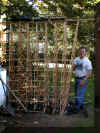
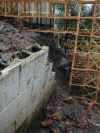
Photo #1 (from left above) About 28' completed. Another forty feet of gradually shrinking height
bents to make. Not yet sick of bent making. Note the cinder block retaining wall
of some 30-50 years age has not yet fallen. Photo #2 shows winter's water
damage. I knew I should have rebuilt the wall first! Now I will end up cutting
trestle away then reinstalling after rebuilding the wall. Ah, the challenges of
outdoor layouts.

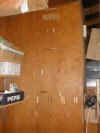
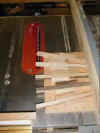

Jigs
helped for small bents. Large bents were made by using jig shown in first photo
to left above. Cedar was used for all wood parts. 1/4" crown staples 1
1/2" to 2" long were used to hold header to legs while Gorilla glue
set. Polyurethane glue requires some of Oregon's natural weather (wet) to set.
Gorilla glue is impervious to water after setting. Horizontal and cross braces
were placed after stapling the header to legs by using a carpenter's square
placed against the inner two vertical legs. The outside legs are angled about 12
degrees. The third photo shows a rapid way to cut top and bottom of legs to
correct angle using the jig. Legs longer than six feet were cut using a mitre
guage then stapled to the header in the jig. The middle photo shows a jig made
on the garage wall. This was useful but slower and more awkward than using a
carpenter's square and assembling on the garage floor or on the lawn. Knee pads
are required. Photo #4 shows some equipment used: Air compressor, 1/4"
crown stapler, shovel, trowel, bag of dobe blocks, wheel barrow with 1/4"
minus crushed granite, pick, cheap flush Japaneese style cutting saw (Harbor
Freight $6), adjustable ladder (had one from other repair projects working on
stair wells), Gorilla glue placed in handy disposable glue syringes, and
AristoCraft Stainless Steel rail in 8' lengths. Rail joints were staggered to
reduce kinking. I used stainless steel rain clamps on trestle joints to ensure
electrical conductivity. Most club members use off the self rail powered
locomotives. Radii on the trestle is 10' to ensure trouble free fast travel. To
date no train has fallen from the trestle despite operation at highest possible
speeds or running trains backwards over the trestle.


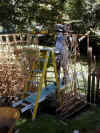

Above left photo shows dobe blocks used as footings. Each leg end is painted
with below grade fence post coating prior to stapling the wire ends of the dobe
block to a leg. Each dobe block is placed in a small hole with 1/4" minus
crushed gravel to keep moisture away and help stabilize the block in a medium
that permits some movement as weather causes expansion and contraction. Photo #2
shows garage mess complete with a tiny fraction of the huge amount of cedar saw
dust created by cutting 12' long 2" x 6" cedar boards into trestle
parts. Photo #3 shows the system I used to work on 8' high trestle on a slope.
Photo #4 shows two stepping stones cast into plastic saucers used to contain
excess water from a pot. I pressed maple leaves into the wet cement and removed
the leaves once the cement was firm but not set hard.
|